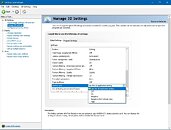- Joined
- Oct 9, 2007
- Messages
- 47,853 (7.38/day)
- Location
- Dublin, Ireland
| System Name | RBMK-1000 |
|---|---|
| Processor | AMD Ryzen 7 5700G |
| Motherboard | Gigabyte B550 AORUS Elite V2 |
| Cooling | DeepCool Gammax L240 V2 |
| Memory | 2x 16GB DDR4-3200 |
| Video Card(s) | Galax RTX 4070 Ti EX |
| Storage | Samsung 990 1TB |
| Display(s) | BenQ 1440p 60 Hz 27-inch |
| Case | Corsair Carbide 100R |
| Audio Device(s) | ASUS SupremeFX S1220A |
| Power Supply | Cooler Master MWE Gold 650W |
| Mouse | ASUS ROG Strix Impact |
| Keyboard | Gamdias Hermes E2 |
| Software | Windows 11 Pro |
NVIDIA has stopped recommending "V-Sync OFF" as a global setting, starting with its GeForce 461.09 WHQL drivers. The NVIDIA Control Panel utility, which lets users configure global- and application-specific 3D settings, uses a tiny NVIDIA logo to denote recommended settings. Its V-Sync settings let you select between "Use 3D Application Settings," global Off, global On, and "Adaptive V-Sync."
NVIDIA explains that it changed this recommendation as the GeForce drivers since 461.09 support MPO (multiple plane overlay). Prior to 461.09, the Windows 10 DWM (desktop windows manager) would composit the contents of all windows into a single plane and presented at display refresh-rate cadence, so tearing was avoided even with V-Sync globally off. With MPO, applications are allowed to present their contents independently, each with their own V-Sync setting. The OS, outside of driver control, decides which apps get promoted to their own MPO plane. This would lead to screen-tearing if V-Sync is globally off, even in Windowed or Windowed-Maximized (pseudo-fullscreen) modes.

View at TechPowerUp Main Site
NVIDIA explains that it changed this recommendation as the GeForce drivers since 461.09 support MPO (multiple plane overlay). Prior to 461.09, the Windows 10 DWM (desktop windows manager) would composit the contents of all windows into a single plane and presented at display refresh-rate cadence, so tearing was avoided even with V-Sync globally off. With MPO, applications are allowed to present their contents independently, each with their own V-Sync setting. The OS, outside of driver control, decides which apps get promoted to their own MPO plane. This would lead to screen-tearing if V-Sync is globally off, even in Windowed or Windowed-Maximized (pseudo-fullscreen) modes.

View at TechPowerUp Main Site




